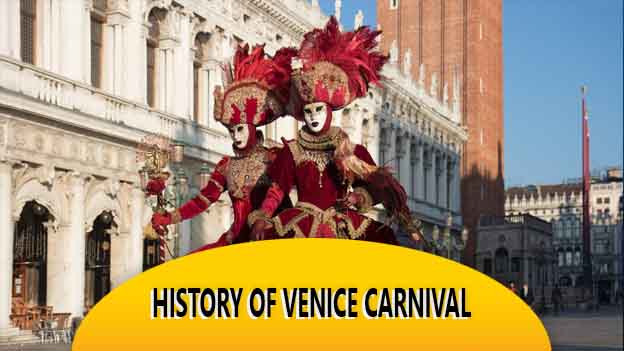History Of Venice Carnival: The Venice Carnival is an enchanting and iconic celebration that has captivated the hearts of millions of people worldwide. With its roots dating back to the 11th century, this historical event has evolved into a grand spectacle of elaborate masks, dazzling costumes, and lively festivities. In this article, we will delve into the captivating history of the Venice Carnival, exploring its origins, traditions, and cultural significance.
Origins of the Venice Carnival
Early Origins
The origins of the Venice Carnival can be traced back to the 11th century, where the celebration began as a way for the locals to indulge in excesses before the period of Lent. During this time, Venetians would engage in lavish feasts, masquerade balls, and various festivities.
Official Recognition
In the 13th century, the Venice Carnival was officially recognized by the Venetian Republic, and regulations were put in place to ensure that the celebrations were held with proper decorum and order. History Of Venice Carnival.
The Golden Age of the Venice Carnival
The Masked Society
The Renaissance period marked the Golden Age of the Venice Carnival. During this time, masks became an integral part of the festivities, allowing people from different social classes to mingle freely without revealing their identities. The use of masks also provided a sense of anonymity, encouraging uninhibited behavior and creativity.
The Art of Masks
The art of mask-making flourished during the Golden Age. Skilled artisans crafted exquisite masks adorned with feathers, gems, and intricate designs, turning the Carnival into a mesmerizing display of artistry and craftsmanship.
- Also Read:
Decline and Resurgence
Decline
In the 18th century, the Venice Carnival began to lose its original spirit due to excessive indulgence and debauchery. As a result, the authorities imposed stricter regulations, leading to a decline in the carnival’s popularity.
Resurgence in the 20th Century
In the 20th century, a group of Venetian artists and scholars decided to revive the tradition of the Venice Carnival. They aimed to restore its cultural significance and historical charm, emphasizing the importance of traditional costumes, masks, and performances.
The Modern Venice Carnival
Dates and Duration
Today, the Venice Carnival takes place over a period of about two weeks, usually in February. The exact dates vary from year to year, as they are based on the Easter calendar.
Major Events and Attractions
The modern Venice Carnival hosts a myriad of events and attractions, such as the Grand Opening Ceremony, where a spectacular procession of costumed participants parades through the streets of Venice. Other highlights include the Best Mask Contest, Water Parade, and the Flight of the Angel, where an acrobat descends from the St. Mark’s Campanile.
Cultural Significance and Impact
Celebration of Identity and Freedom
The Venice Carnival continues to serve as a celebration of identity and freedom. The masks symbolize the equality of all participants, allowing them to escape societal constraints and express themselves without judgment.
Boost to Tourism
The Carnival has become a significant boost to Venice’s tourism industry. Every year, thousands of tourists flock to the city to witness the magical atmosphere and take part in the festivities.
Conclusion
History Of Venice Carnival: The Venice Carnival, with its rich history and cultural significance, remains an extraordinary event that keeps the spirit of tradition and creativity alive. From its early origins as a simple pre-Lenten festivity to its evolution into a dazzling spectacle of artistry and celebration, the Venice Carnival continues to enchant and inspire people from all corners of the world.
FAQs: History Of Venice Carnival
-
What is the significance of masks in the Venice Carnival?
Masks in the Venice Carnival have historical significance as they allowed people to interact freely, irrespective of social class, promoting a sense of equality and anonymity.
-
When does the Venice Carnival take place?
The Venice Carnival typically takes place over two weeks in February, with the dates varying each year based on the Easter calendar.
-
What are some major events during the modern Venice Carnival?
The modern Venice Carnival features events like the Grand Opening Ceremony, Best Mask Contest, Water Parade, and the Flight of the Angel.
-
How did the Venice Carnival experience a resurgence in the 20th century?
In the 20th century, Venetian artists and scholars worked together to revive the Carnival’s traditions, emphasizing traditional costumes, masks, and performances.
-
What impact does the Venice Carnival have on tourism?
The Venice Carnival has a significant impact on tourism, attracting thousands of visitors to the city each year to experience the unique and magical atmosphere of the festivities.
